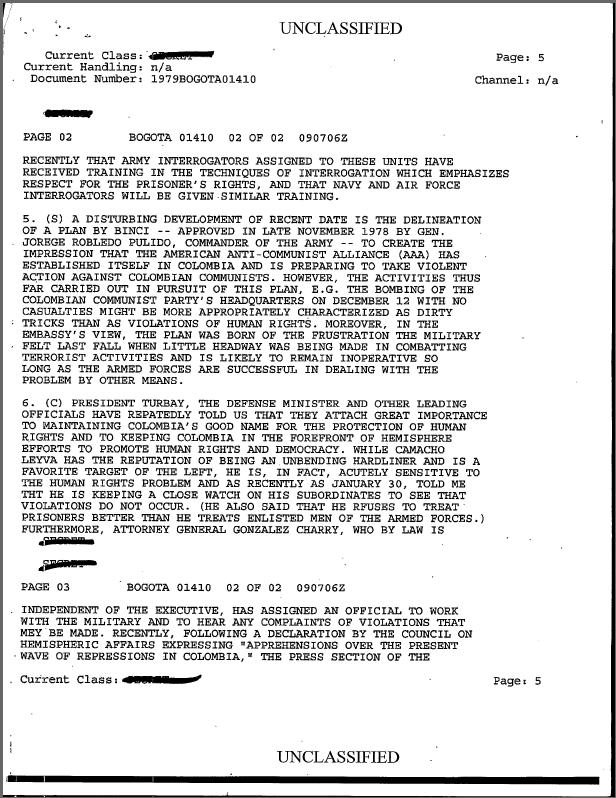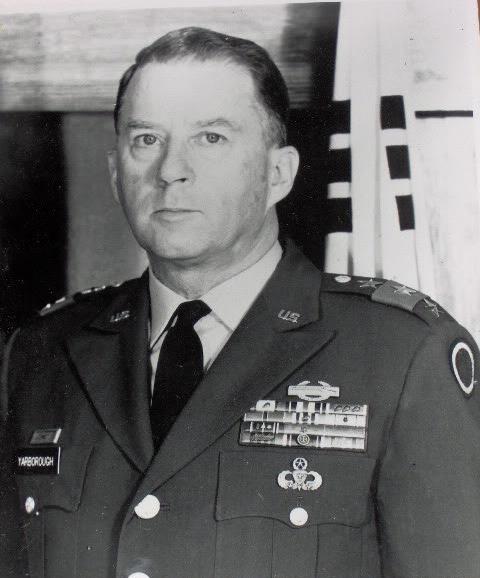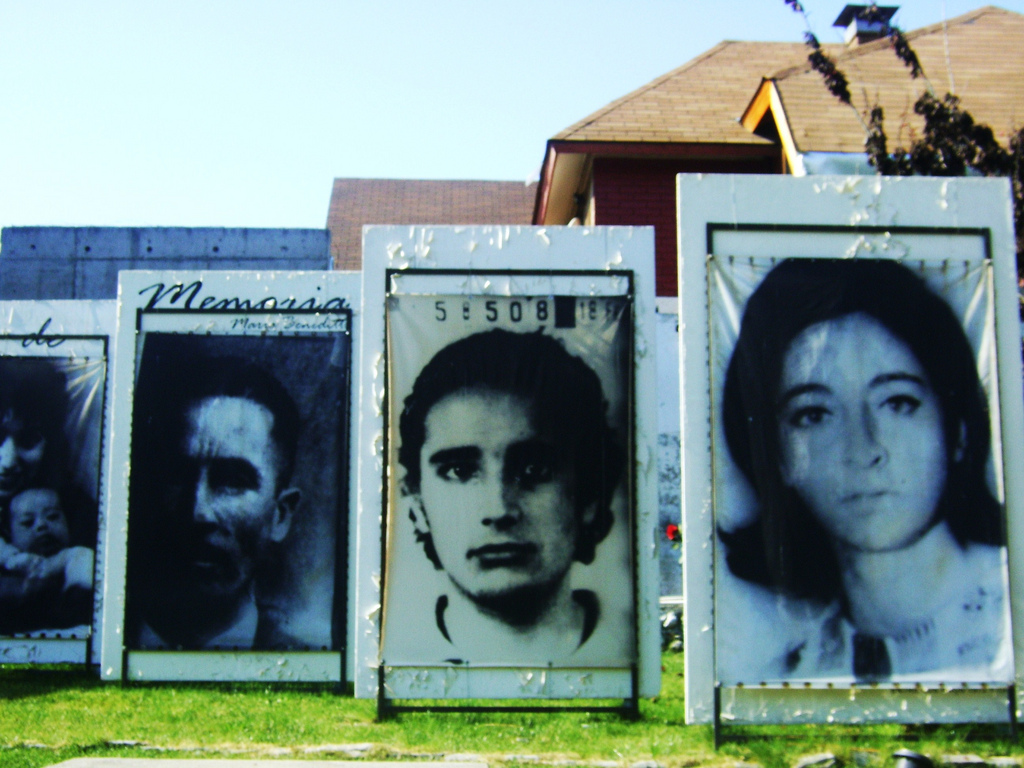|
BINCI
The Batallón Único de Inteligencia y Contrainteligencia () of the Colombian National Army. The BINCI has also been referred to as the "Charry Solano battalion," after its original chief, Brigadier General Ricardo Charry Solano. It has also been known as the Twentieth Brigade or Brigade XX. Controversy Triple A During the years of its operation, the BINCI was considered the Colombian National Army's primary counter-intelligence unit and under direct operational control of the E-2 Army intelligence directorate in Bogotá, Colombia. A declassified 1979 report from the United States Embassy in Bogotá, published in 2007 by the National Security Archive, mentioned that there was a plan for the BINCI to form a paramilitary operation under the guise of the Alianza Americana Anticomunista (AAA). The report describes the goal of the formation of the AAA as "to create the impression that the American Anti-communist Alliance has established itself in Colombia and is preparing to take viol ... [...More Info...] [...Related Items...] OR: [Wikipedia] [Google] [Baidu] [Amazon] |
Alianza Americana Anticomunista
The ''Alianza Americana Anticomunista'' (AAA, pronounced triple-A; "American Anticommunist Alliance") was a paramilitary far-right group mainly operating in Colombia between 1978 and 1979. Contemporary accusations and declassified U.S. Embassy documents have linked the creation and operation of this group to members of a Colombian National Army battalion employing the Triple A name as a label. Foundation A 1979 report from the United States Embassy in Bogotá, Colombia details that then-General Jorge Robledo Pulido and members of the BINCI, "Charry Solano" Battalion of Intelligence and Counterintelligence (BINCI) were directly involved in the creation of AAA. The report describes a plan intended "to create the impression that the American Anti-communist Alliance has established itself in Colombia and is preparing to take violent action against local communists." Accusations and activities In December 1978, the Anticommunist American Alliance bombed the Colombian Communist Party ... [...More Info...] [...Related Items...] OR: [Wikipedia] [Google] [Baidu] [Amazon] |
Paramilitarism In Colombia
Right-wing paramilitary groups in Colombia () are paramilitary groups acting in opposition to revolutionary Marxist–Leninist guerrilla forces and their allies among the civilian population. These right-wing paramilitary groups control a large majority of the illegal drug trade of cocaine and other substances. The Colombian National Centre for Historical Memory has estimated that between 1981 and 2012 paramilitary groups have caused 38.4% of the civilian deaths, while the Guerillas are responsible for 16.8%, 10.1% by the Colombian Security Forces and 27.7% by non-identified armed groups. The first paramilitary groups were organized by the Colombian military following recommendations made by U.S. military counterinsurgency advisers who were sent to Colombia during the Cold War to combat leftist political activists and armed guerrilla groups. The development of more modern paramilitary groups has also involved elite landowners, drug traffickers, members of the security forces, ... [...More Info...] [...Related Items...] OR: [Wikipedia] [Google] [Baidu] [Amazon] |
Colombian National Army
The National Army of Colombia () is the land warfare service branch of the Military Forces of Colombia. With over 361,420 active personnel as of 2020, it is the largest and oldest service branch in Colombia, and is the second largest army in the Americas after the US Army, United States and before Brazilian Army, Brazil. It is headed by the Commandant of the National Army (), falls under the authority of the Commandant General of the Military Forces (), and is supervised by the Ministry of National Defense (Colombia), Ministry of National Defense, which answers to the President of Colombia. The modern Colombian Army has its roots in the Army of the Commoners (), which was formed on 7 August 1819 – before the establishment of the present day Colombia – to meet the demands of the Bolívar's campaign to liberate New Granada, Revolutionary War against the Spanish Empire. After their triumph against the Spanish, the Army of the Commoners disbanded, and the Congress of Angostura c ... [...More Info...] [...Related Items...] OR: [Wikipedia] [Google] [Baidu] [Amazon] |
Forced Disappearance
An enforced disappearance (or forced disappearance) is the secret abduction or imprisonment of a person with the support or acquiescence of a State (polity), state followed by a refusal to acknowledge the person's fate or whereabouts with the intent of placing the victim outside the protection of the law. Often, forced disappearance implies murder whereby a victim is kidnapping, abducted, may be illegally prison, detained, and is often tortured during interrogation, ultimately killed, and the body disposed of secretly. The party committing the murder has plausible deniability as there is no evidence of the victim's death. Enforced disappearance was first recognized as a human rights issue in the 1970s as a result of Detenidos Desaparecidos, its use by military dictatorships in Latin America during the Dirty War. However, it has occurred all over the world. According to the Rome Statute of the International Criminal Court, which came into force on 1 July 2002, when committed as ... [...More Info...] [...Related Items...] OR: [Wikipedia] [Google] [Baidu] [Amazon] |
Counterterrorism
Counterterrorism (alternatively spelled: counter-terrorism), also known as anti-terrorism, relates to the practices, military tactics, techniques, and strategies that governments, law enforcement, businesses, and Intelligence agency, intelligence agencies use to combat or eliminate terrorism and violent extremism. If an act of terrorism occurs as part of a broader insurgency (and insurgency is included in the definition of terrorism) then counterterrorism may additionally employ counterinsurgency measures. The United States Armed Forces uses the term "foreign internal defense" for programs that support other countries' attempts to suppress insurgency, lawlessness, or subversion, or to reduce the conditions under which threats to national security may develop. History The first counterterrorism body to be formed was the Special Irish Branch of the Metropolitan Police, later renamed the Special Branch (Metropolitan Police), Special Branch after it expanded its scope beyond its or ... [...More Info...] [...Related Items...] OR: [Wikipedia] [Google] [Baidu] [Amazon] |
National Army Of Colombia
The National Army of Colombia () is the land warfare service branch of the Military Forces of Colombia. With over 361,420 active personnel as of 2020, it is the largest and oldest service branch in Colombia, and is the second largest army in the Americas after the United States and before Brazil. It is headed by the Commandant of the National Army (), falls under the authority of the Commandant General of the Military Forces (), and is supervised by the Ministry of National Defense, which answers to the President of Colombia. The modern Colombian Army has its roots in the Army of the Commoners (), which was formed on 7 August 1819 – before the establishment of the present day Colombia – to meet the demands of the Revolutionary War against the Spanish Empire. After their triumph against the Spanish, the Army of the Commoners disbanded, and the Congress of Angostura created the Gran Colombian Army to replace it. Throughout its history, the Colombian Army has seen action in s ... [...More Info...] [...Related Items...] OR: [Wikipedia] [Google] [Baidu] [Amazon] |
Politics Of Colombia
Colombia is a presidential representative democratic republic with a multi-party system, where the President of Colombia is both head of state and head of government. The national government has separate executive, legislative, and judicial branches. The legislative power is held by the two chambers of the Congress of Colombia, the Senate and the Chamber of Representatives. The judiciary is independent of the executive and the legislature, with the four high courts for each jurisdiction of law: the Constitutional Court of Colombia, Supreme Court of Justice of Colombia, Council of State, and Superior Council of Judicature. Constitution The current Colombian Constitution of 1991, enacted on July 5, 1991, strengthened the administration of justice with the provision for introduction of an adversarial system, which entirely replaced the existing Napoleonic Code. Other significant reforms under the new constitution included civil divorce, dual nationality, the office of Vic ... [...More Info...] [...Related Items...] OR: [Wikipedia] [Google] [Baidu] [Amazon] |
Military Of Colombia
The Military Forces of Colombia () are the unified armed forces of the Colombia, Republic of Colombia. They consist of the National Army of Colombia, Colombian Army, the Colombian Navy and the Colombian Aerospace Force. The National Police of Colombia, although technically not part of the military, is controlled and administered by the Ministry of National Defense (Colombia), Ministry of National Defence, and national conscription also includes service in the National Police, thus making it a ''de facto'' gendarmerie and a branch of the military. The President of Colombia is the military's commander in chief, and helps formulate defense policy through the Ministry of National Defence, which is in charge of day-to-day operations. The Military Forces of Colombia have their roots in the Army of the Commoners (), which was formed on 7 August 1819 – before the establishment of the present day Colombia – to meet the demands of the Bolívar's campaign to liberate New Granada, Revolut ... [...More Info...] [...Related Items...] OR: [Wikipedia] [Google] [Baidu] [Amazon] |





